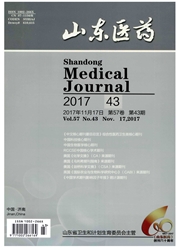

 中文摘要:
中文摘要:
目的:观察不同时间点小鼠后肢缺血模型肌肉组织中S1 P受体的基因表达情况,探讨其在后肢缺血模型血管新生及血流恢复中的作用。方法:将18只8~12周龄C57 Bl/6 J小鼠随机分为3 d组,即术后3 d组、术后7 d组及术后14 d组,每组6只。采用戊巴比妥麻醉小鼠,取仰卧位,钝性分离皮肤肌肉等外周组织后,分别结扎小鼠左后肢股动静脉及其分支后缝合,建立小鼠后肢缺血模型。分别于术后第1、3、5、7、10和14天采用激光多普勒血流分析仪观察缺血后肢血流变化情况。于术后第3、7和14天处死动物取腓肠肌组织行CD31免疫组织化学染色,计数微脉管密度,并提取腓肠肌组织中RNA,应用实时定量荧光PCR( real-time PCR)技术测定腓肠肌组织中S1P受体的mRNA表达情况。结果:术后14 d内,缺血侧与未缺血侧血流比值及缺血侧CD31阳性染色微脉管密度随时间改变逐渐增加。术后第3天,S1P1、S1P2和S1P3受体mRNA表达水平显著性增高,差异有统计学意义(P0.05)。结论:小鼠后肢缺血后的血管新生和血流恢复情况在早期可能与S1P1受体、S1P2受体和S1P3受体上调有关,随后与S1P2受体上调有关。
 英文摘要:
英文摘要:
Objective:To investigate the expression of S1P receptor mRNA level in ischemic hindlimbs of mice at different time points, in order to discuss possible effects on angiogenesis and blood flow recovery. Methods:8-12 weeks old male C57Bl/6J mice were randomized divided into 3 groups:post-operative day 3 group, post-operative day 7 group and post-operative day 14 group, 6 mice for each group. Mice were subjected to surgical procedures to achieve unilateral hindlimb ischaemia after intraperitoneal injection of pentobarbital. In brief, following a skin incision at the left paracenter of the lower abdomen, the femoral artery, which originated from the external iliac artery and terminated to bifurcate into the saphenous and the popliteal arteries, was excised. The blood flow was observed at post-operative day 1, 3, 5, 7, 10 and 14 by laser Doppler blood flow analyzer. Ischemic tissue of calf muscle was excised at different time points for immunohistochemistry and real-time PCR to detect the capillary density and the expression of S1P receptor mRNA level. Results:The blood flow and capillary density in ischemic hindlimb were increased during the 14 days after operation. The mRNA expression of S1P1 and S1P3 was increased in ischemic limb muscle compared with non-ischemic limb muscle on post-operative day 3 ( P0. 05). There was significant difference of S1P2 mRNA level between ischemic hind limbs and non-ischemic hindlimbs on the post-operative day 3 , 7 and 14 ( P 〈0 . 05 ) . Conclusion:The mRNA expressions of S1P1 , S1P2 and S1P3 increase in the early time phase, and only S1P2 later in ischemic hindlimbs for angiogenesis and blood flow recovery.
 同期刊论文项目
同期刊论文项目
 同项目期刊论文
同项目期刊论文
 期刊信息
期刊信息
